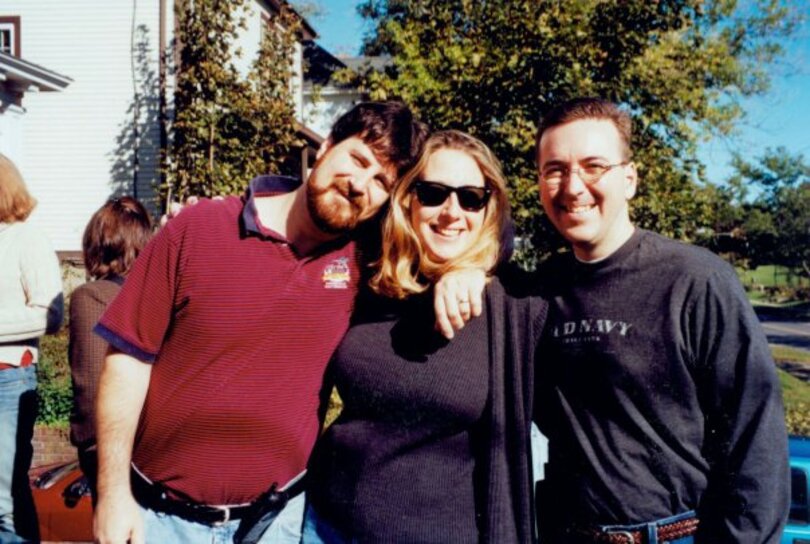DO Palooza’s origin story: How some trouble and a joke spawned The Daily Orange’s treasured alumni weekend

Courtesy of Linda Epstein
Andrew Gross, Linda Epstein and Jim Carty pose on the front lawn of 744 Ostrom Ave. for the first D.O. Palooza. The event began informally in 2002 and was never intended to be held annually. However, due to the efforts of D.O. management teams, it's been held nearly every year since.
UPDATED: Feb. 17, 2017 at 11:22 a.m.
When Andrew Garcia Phillips last visited 744 Ostrom Ave., the house felt a little draftier than he remembered.
All the doors were gone.
“I was like, when did that happen?” said Phillips, who was editor in chief from 1996-97.
He thought the tale would be Daily Orange lore, lost to history. But after musing with other alumni, he got an answer (some say people were tired of slamming doors, others say it was to cut down on gossip during production).
Hearing stories like these is one reason former Daily Orange staff members come back to upstate New York to attend D.O. Palooza, where the old and young talk everything from design to political reporting. It’s a time of reconnecting and networking. But the alumni mixer might never have taken off had The D.O. not had been in hot water.

When Tito Bottitta was editor in chief in 2002, the paper was in trouble because of a comic that had been perceived as racist, he said. The staff began talking about ways to improve The D.O. and make sure a similar incident didn’t happen again. The idea for Palooza took shape.
“I feel like there’s always something that’s kind of piquing the alumni interest, and bringing them back in and giving them a reason to kind of talk to the current staff,” Bottitta said.
Alumni Jim Carty and Ben Rand helped round up attendees for the inaugural Palooza. It was pre-social media, Rand said, but word spread quickly.
The two began sending emails to massive groups of people, consulting the alumni directory and then comparing to mastheads, said Rand, who was editor in chief from 1986-87.
“A lot of ways it was like pre-viral viral,” said Carty, who was assistant editorial editor and assistant sports editor between 1988-90. “We reached out to the people within our own networks, but then they began to reach out to people in their own networks, and all of a sudden we were getting emails from people who wanted to participate and who would bring something to the table for a panel.”
When thinking about what to call the event, Carty jokingly said it would be a “D.O. palooza.” But the unintentional “placeholder” name became the one that stuck, which didn’t hit Carty until he and Rand saw the first posters.
After the first Palooza, the event skipped a year for The D.O.’s 100th anniversary celebration in 2003. A few other years have gone by without Palooza. It wasn’t meant to be annual, Bottitta said. They thought that if it were less often, like biannual, it would be more special for alumni.
Phillips said it’s interesting to learn what new generations have done on their own initiative, like creating the video and social media teams. He also gets to observe changes in staff culture — evidenced by, among other things, the removal of the doors.
“It’s like a slow evolution to things. You walk through and you see all these little things that you remember doing, and people continue to sort of do that same thing and they don’t know where that came from,” Phillips said. “It’s kind of like a game of telephone that’s played over decades of time.”
Besides reminiscing, Palooza is a great opportunity for alumni to give back, said Dave Levinthal, editor in chief in 2000. This year’s Palooza will be Levinthal’s fourth, and it’s “invigorating” to see what the staff is up to now.
“I love listening as much as talking, hearing the stories of how D.O. reporters and editors are fighting battles with the SU administration, going on crazy adventures and understanding the challenges that they’re facing while being full time-reporters and full-time students,” he said. “It’s crazy hard, and all of us alumni, we’ve been there.”
The benefits go both ways — anyone who attends Palooza leaves with at least a dozen and one new ideas or tricks, Levinthal said.
When students reach out for jobs and internships, the networking done at Palooza can help get their foot through the door, said Linda Epstein, The D.O.’s photo editor from 1987-89 and an attendee at the first Palooza in 2002. When she was in the business of hiring freelancers, she would be inclined to hire Syracuse students first.
Although Palooza has skipped some years, Rand said he is heartened to know that it is still being planned. Listening to current staffers’ issues and concerns and being back in the house is “very personal,” he said.
“It has always, always, every time — even professional stuff I come back for — it felt like home,” Rand said. “And I think you’ll find as you go on in your career, you’ll find that pretty much people share that experience.”




